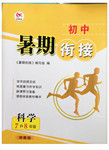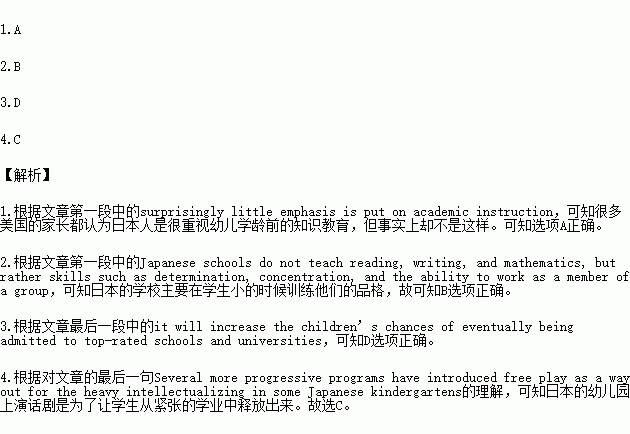题目内容
Many Americans are turning to Japan, they think, a country of high academic(学术的) achievement and economic success, for possible answers.However, the answers provided by Japanese preschools are not the ones Americans expected to find. In most Japanese preschools, surprisingly little emphasis is put on academic instruction.In one survey, 300 Japanese and 210 American preschool teachers, child development specialists, and parents were asked about various aspects of early childhood education.Only 2 percent of the Japanese respondents(答问卷者)listed “to give children a good start academically” as one of their top three reasons for a society to have preschools.In contrast, over half the American respondents chose this as one of their top three choices.To prepare children for successful careers in first grade and beyond, Japanese schools do not teach reading, writing, and mathematics, but rather skills such as determination, concentration, and the ability to work as a member of a group.The huge majority of young Japanese children are taught to read at home by their parents.
Like in America, there is diversity(多样性) in Japanese early childhood education.Some Japanese kindergartens have specific aims, such as early musical training or potential(潜力的) development.In large cities, some kindergartens are attached to universities that have elementary and secondary schools.Some Japanese parents believe that if their young children attend a university-based program, it will increase the children’s chances of eventually being admitted to top-rated schools and universities.Several more progressive programs have introduced free play as a way out for the heavy intellectualizing in some Japanese kindergartens.
1.We learn from the first paragraph that many Americans believe ________.
A. Japanese preschool education emphasizes academic instruction
B. Japanese parents are more involved in preschool education than American parents
C. Japan’s economic success is a result of its scientific achievements
D. Japan’s higher education is superior to theirs
2.In Japan’s preschool education, the focus is on ________.
A. preparing children academically
B. shaping children’s character
C. teaching children mathematics
D. developing children’s artistic interests
3.Why do some Japanese parents send their children to university-based kindergartens?
A. They can do better in their future studies.
B. They can make more group experience grow there.
C. They can be individually oriented when they grow up.
D. They can have better chances of getting a first-rate education.
4.Free play has been introduced in some Japanese kindergartens in order to ________.
A. broaden children’s knowledge
B. train children’s creativity
C. lighten children’s study load
D. enrich children’s experience
 鹰派教辅衔接教材河北教育出版社系列答案
鹰派教辅衔接教材河北教育出版社系列答案 初中暑期衔接系列答案
初中暑期衔接系列答案

